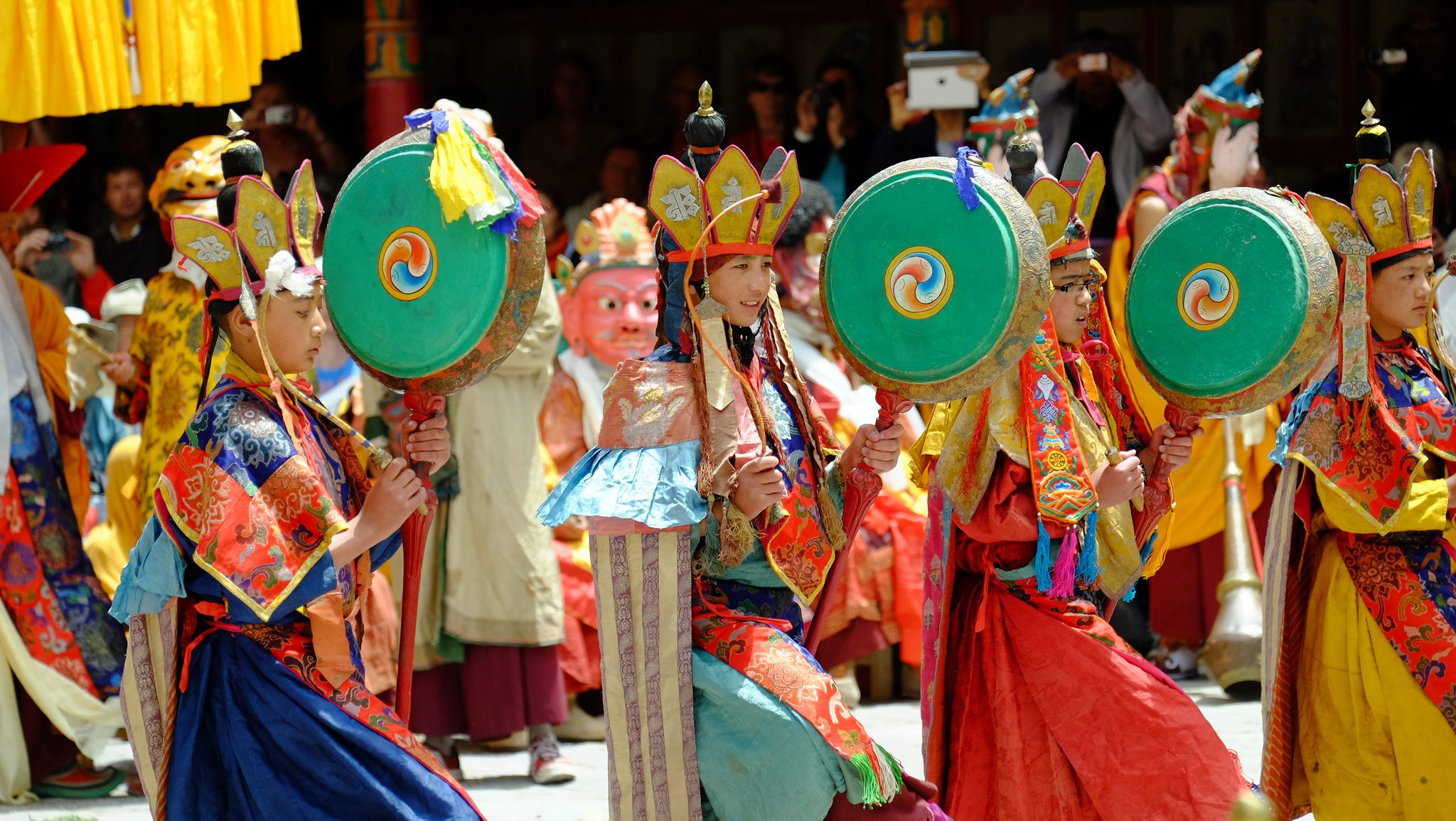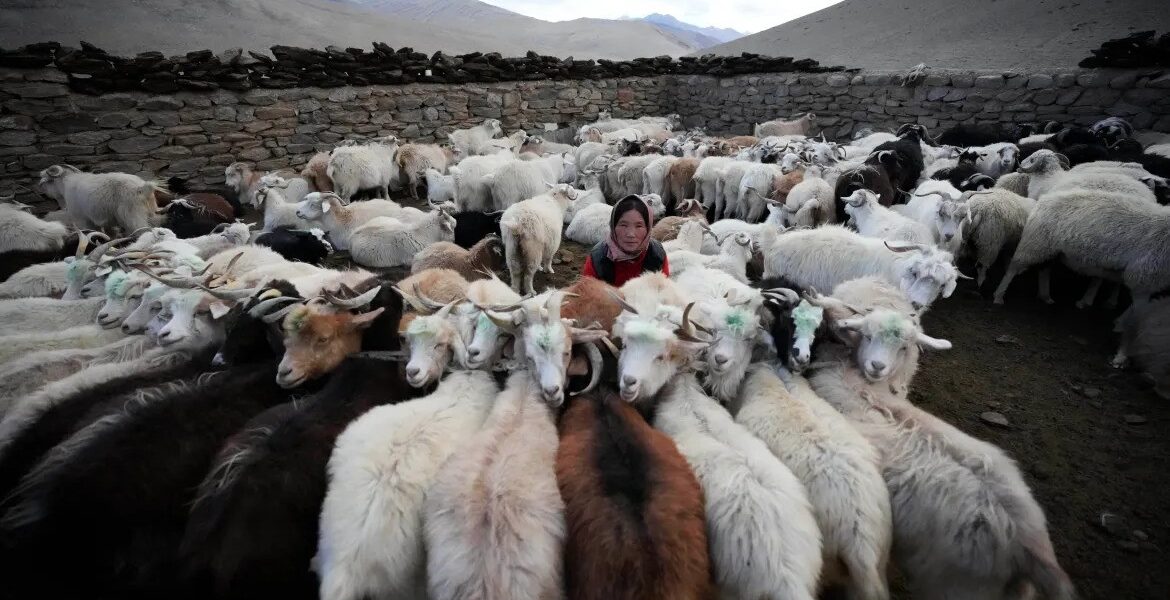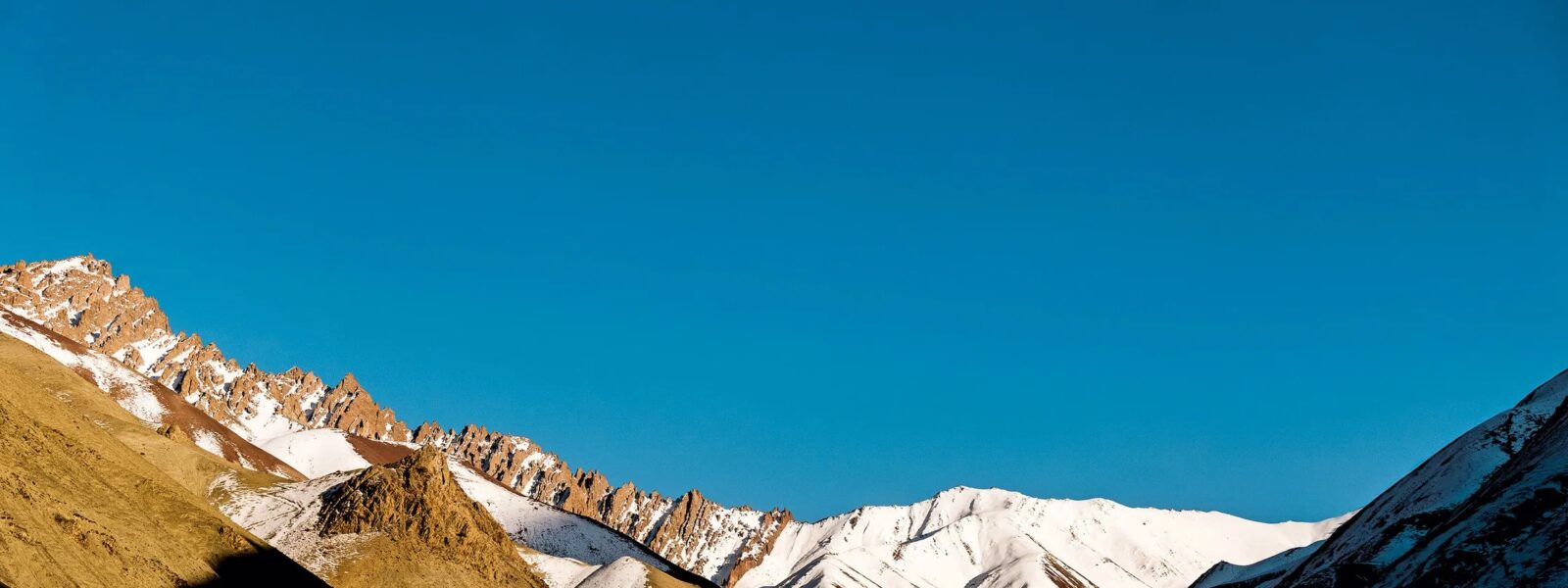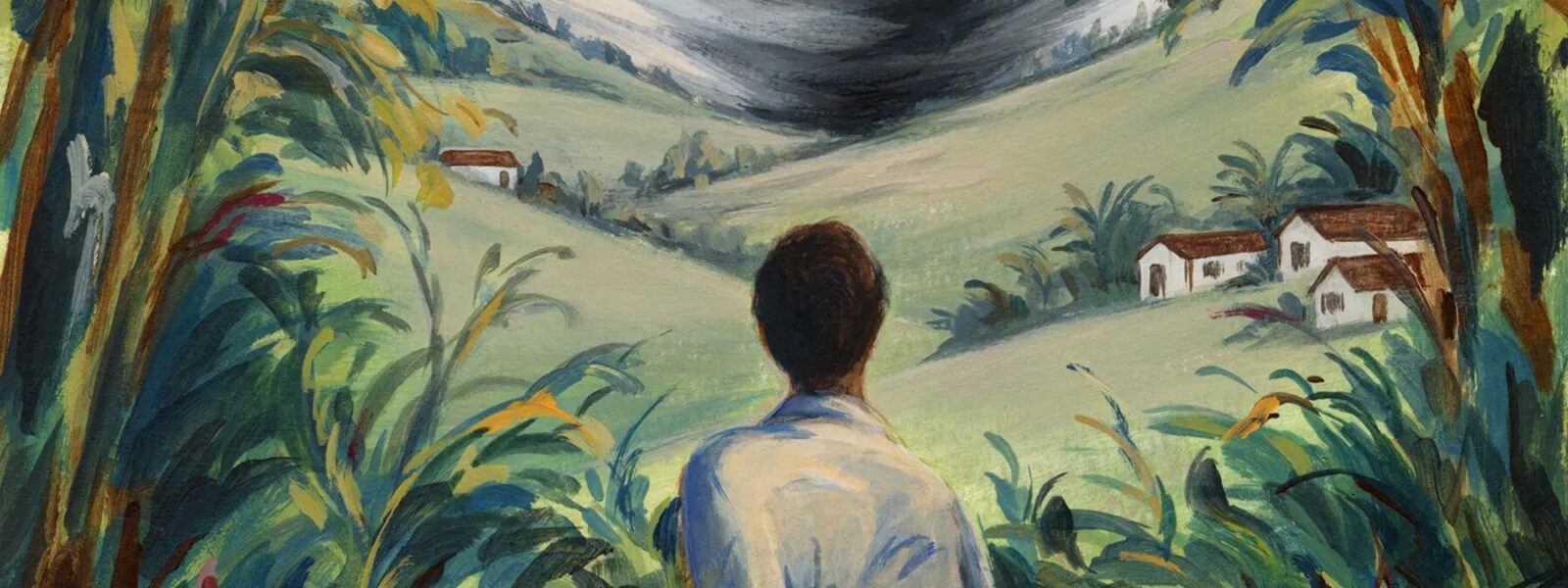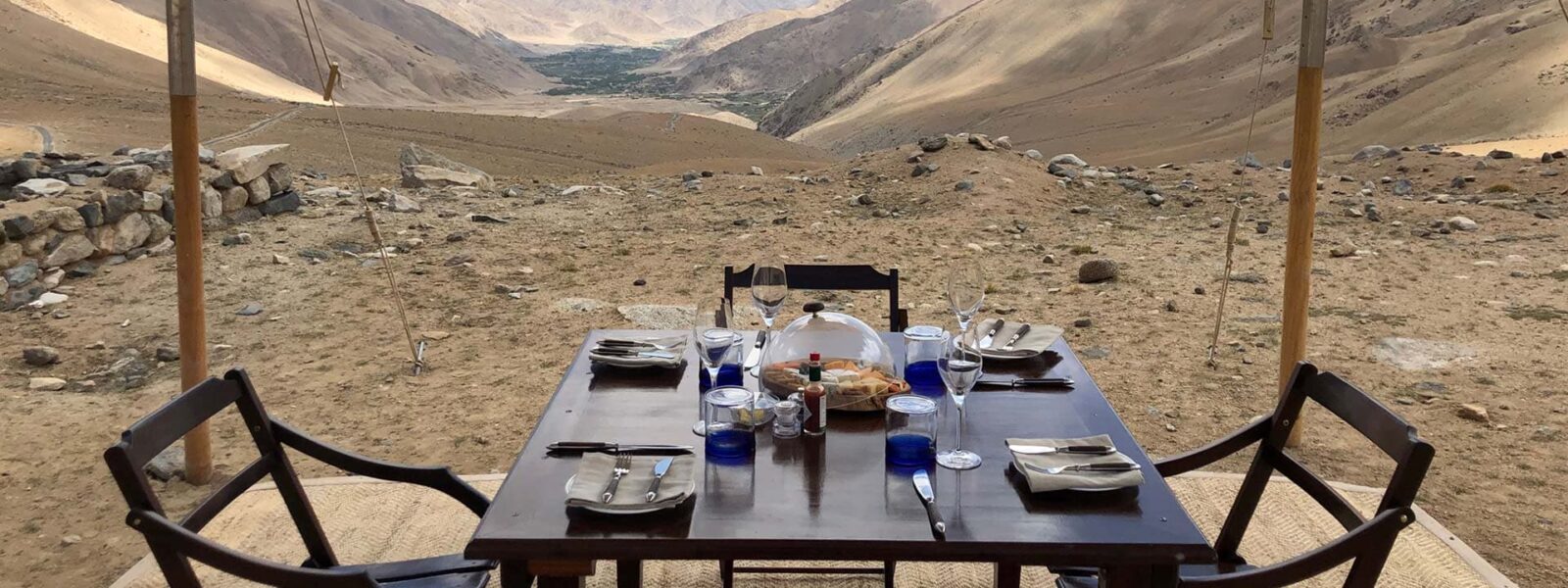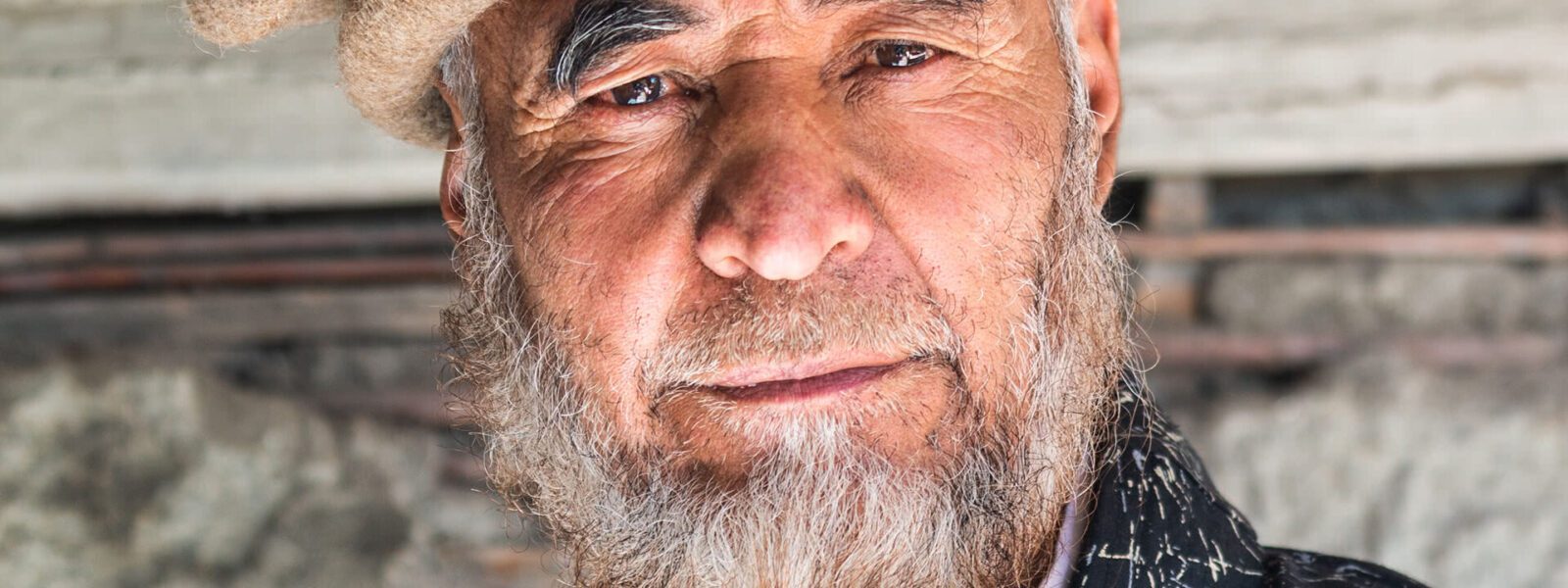Where Silence Ends and Rhythm Begins
It begins not with a bang, but with a whisper—a whisper carried by wind over jagged Himalayan ridges, stirring the faded silk of prayer flags hung like old dreams across the vast blue. At first, you think Ladakh is silence. It feels like the kind of place where even your breath should be quiet. But then, you listen closer. And there it is: a rhythm. Faint at first, like the soft thud of a heart just waking from slumber. A drumbeat. Then another. Then a dozen more, echoing from a monastery hidden somewhere in the folds of the mountains.
This is not just sound. It is invocation, celebration, memory. The drumbeat is Ladakh’s way of telling you that it is very much alive—and that you, too, are invited to join the dance.
For travelers from Europe, used to music emerging from stages or speakers, there’s something primordial about this. In Ladakh, music arises from earth and stone. You hear it not from an instrument but from within the body of the land itself. It’s in the way boots crunch on gravel paths leading to gompas. It’s in the laughter of children preparing for Losar. It’s in the measured footsteps of masked monks who dance not for show, but for the gods.
Here, festivals don’t announce themselves with billboards or online ticketing portals. They ripple outward through villages like waves of energy—a grandmother preparing chang, a child painting wooden masks, a yak decorated with cloth the color of twilight. Festivals in Ladakh are woven into daily life, appearing like sudden dreams and yet known by every villager, every elder, every young initiate in maroon robes.
There’s something extraordinary in the way Ladakh holds space for both solitude and celebration. You can walk for hours in total silence, then round a corner and find a courtyard pulsing with color, movement, and sound. And standing in the middle of it all, you may feel strangely at home—as though some ancient rhythm within you has been remembered at last.
This is where silence ends, and where the real Ladakh begins: in the beating of a drum, the turn of a prayer wheel, and the swirl of robes beneath a sapphire sky.
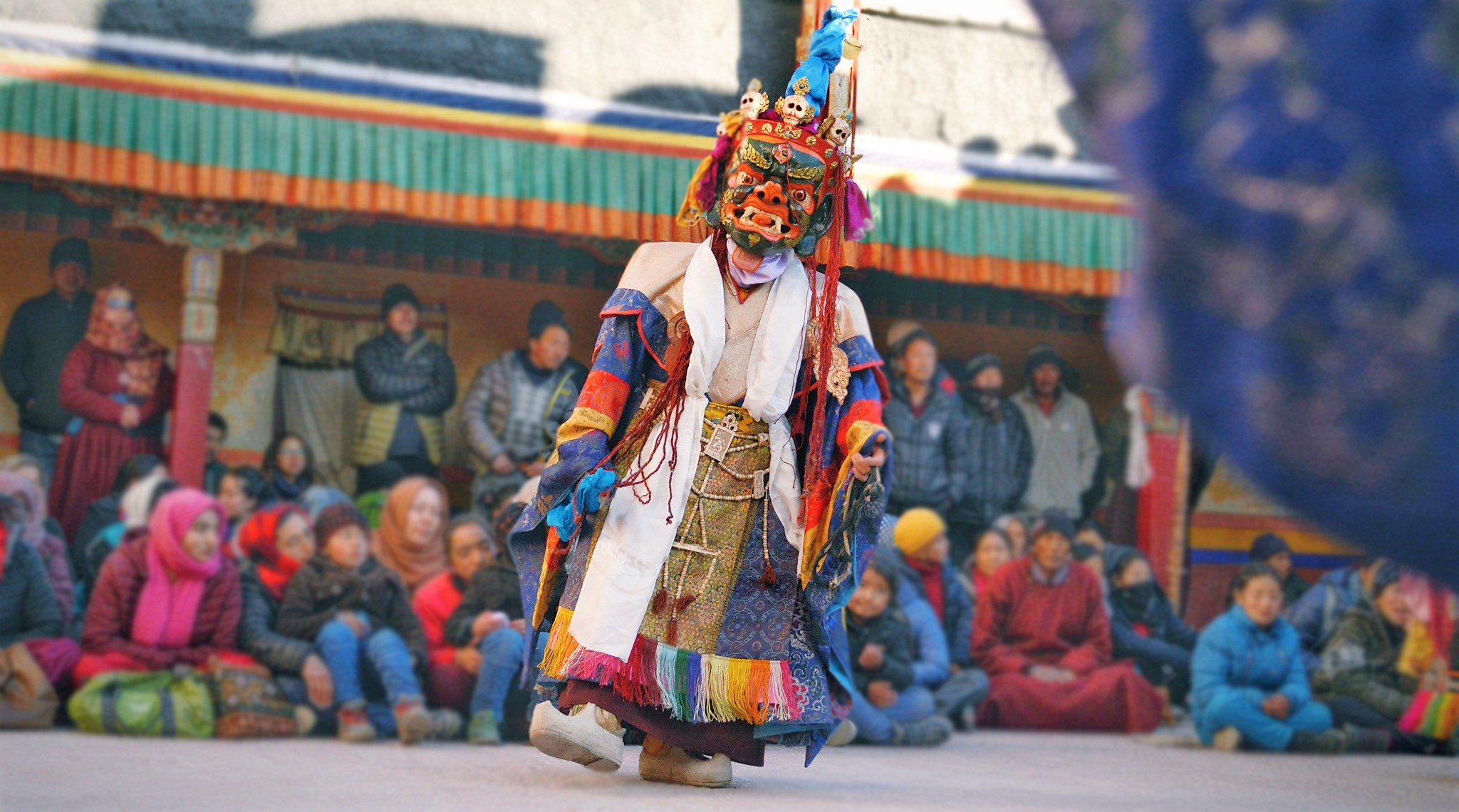
The Drum as Compass: Understanding the Pulse of Ladakhi Culture
If you ever lose your way in Ladakh, don’t look for road signs or digital maps. Instead, follow the drum. It will lead you to the heart of the celebration, and deeper still, to the soul of this land.
In Ladakh, the drum is not merely an instrument—it is a spiritual compass. Its beat marks beginnings and endings, births and farewells, sowing and harvest, meditation and madness. It is in the monasteries, in the narrow alleys of Leh, and even in the hands of children rehearsing stories older than memory. The drum signals that something sacred is about to unfold.
I remember sitting on the stone steps of a gompa in the early morning cold, breath suspended like mist, when I first felt it—not heard, but felt. A deep vibration rising from the earth itself. Then the drums began, slow and deliberate. Each beat moved through my chest like a pulse I had forgotten was mine. Soon, the sound became a guide, drawing villagers from every direction: monks in crimson robes, old women wrapped in hand-woven shawls, curious children trailing behind their fathers. No one asked where they were going. The drums had already answered.
Every festival in Ladakh begins with the drum. Whether at Hemis, the grandest and most photographed of them all, or in the small stone courtyard of an unnamed village gompa, the rhythm remains the same—steady, ancient, and impossibly alive. It is said that the sound connects the human realm to the divine, like a bridge of vibrations spanning this world and the next.
European visitors often speak of the drum as hypnotic, even transcendent. And indeed, there’s something almost meditative in how the beat shapes time. It flattens the urgency of the modern world and stretches minutes into meaningful silences. The drummers—often masked, sometimes barefoot—aren’t performing. They’re transmitting. The rhythm isn’t for the audience. It’s for the mountain, the wind, the ancestors.
To walk alongside a drum-led procession in Ladakh is to walk not just through space, but through story. Every step echoes with generations of ritual, resistance, and reverence. And when you finally arrive—at the festival, the monastery, the open plain where dance and prayer converge—you understand: the drum has not led you to a destination. It has brought you back to something you already carry within.
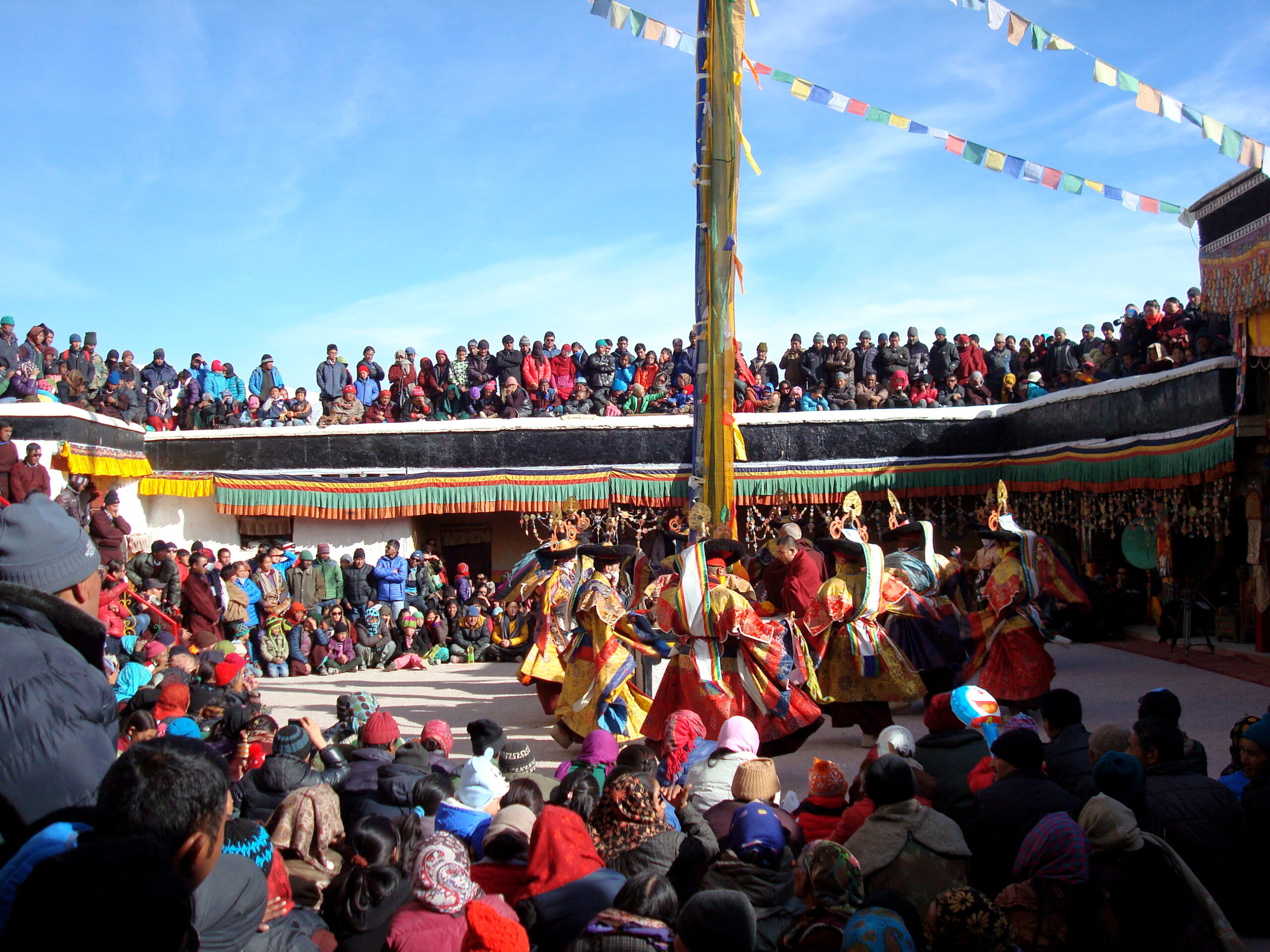
Cham Dances: Stories Carved in Silence and Motion
Long before the first word was ever written in Ladakh, stories lived in the body. They twisted through the air like smoke from incense, they stepped lightly across monastery courtyards in winter wind. They became the Cham.
Cham dances are ritual performances held in Ladakh’s Buddhist monasteries, and they are unlike anything you will find in the West. These dances are not designed to entertain, though they may leave you breathless. They are meditations in motion, prayers translated into movement and masks. Performed during sacred festivals such as the Hemis Tsechu, Phyang Tsedup, or Dosmochey, the Cham is the most profound theatrical expression of Ladakhi spirituality.
I remember standing in a crowded monastery yard, wrapped in a borrowed wool shawl, while snow swirled lazily through the thin mountain air. The monks emerged slowly, one by one, faces hidden behind elaborately painted masks—wrathful deities with bulging eyes, benevolent bodhisattvas with serene smiles, wild animals, skeletons, demons. The effect was both strange and strangely familiar, like watching a dream you once had but never understood.
And then, without warning, the drums began. With each beat, the courtyard transformed into a different realm. The monks moved in wide arcs, slowly at first, then with sudden bursts—jumps, spins, bows, gestures with long flowing sleeves. It was not random. Each motion told a tale: of triumph over ignorance, of cosmic battles between compassion and illusion, of the eternal cycle of life, death, and rebirth.
There is no spoken word. The language here is rhythm, breath, gaze. Silence is part of the story. A Cham dancer might pause completely, still as stone, before erupting into a whirl of red and gold. These silences speak too—of reverence, of waiting, of spiritual stillness before revelation.
For many visitors, especially those arriving from Europe’s cathedrals and concert halls, the Cham feels like entering a parallel form of worship. One where faith is danced, not declared. The music is raw—made from drums, horns, and long trumpets that moan like wind over a glacier. The air smells of juniper and yak butter lamps. The earth shakes, a little, with every stomp of the dancer’s boot.
These performances aren’t staged for tourists. They would happen whether anyone came to watch or not. And this is perhaps what makes them sacred still. As an outsider, you do not need to understand every symbol. You simply need to witness it with openness, to allow the rhythm to enter your chest and stir something quiet inside you.
In that courtyard, I didn’t just observe a dance. I entered a living myth. And when the final drumbeat fell into silence, it felt like a door had quietly closed—and yet, part of me had stayed behind, still spinning beneath those ancient mountain skies.
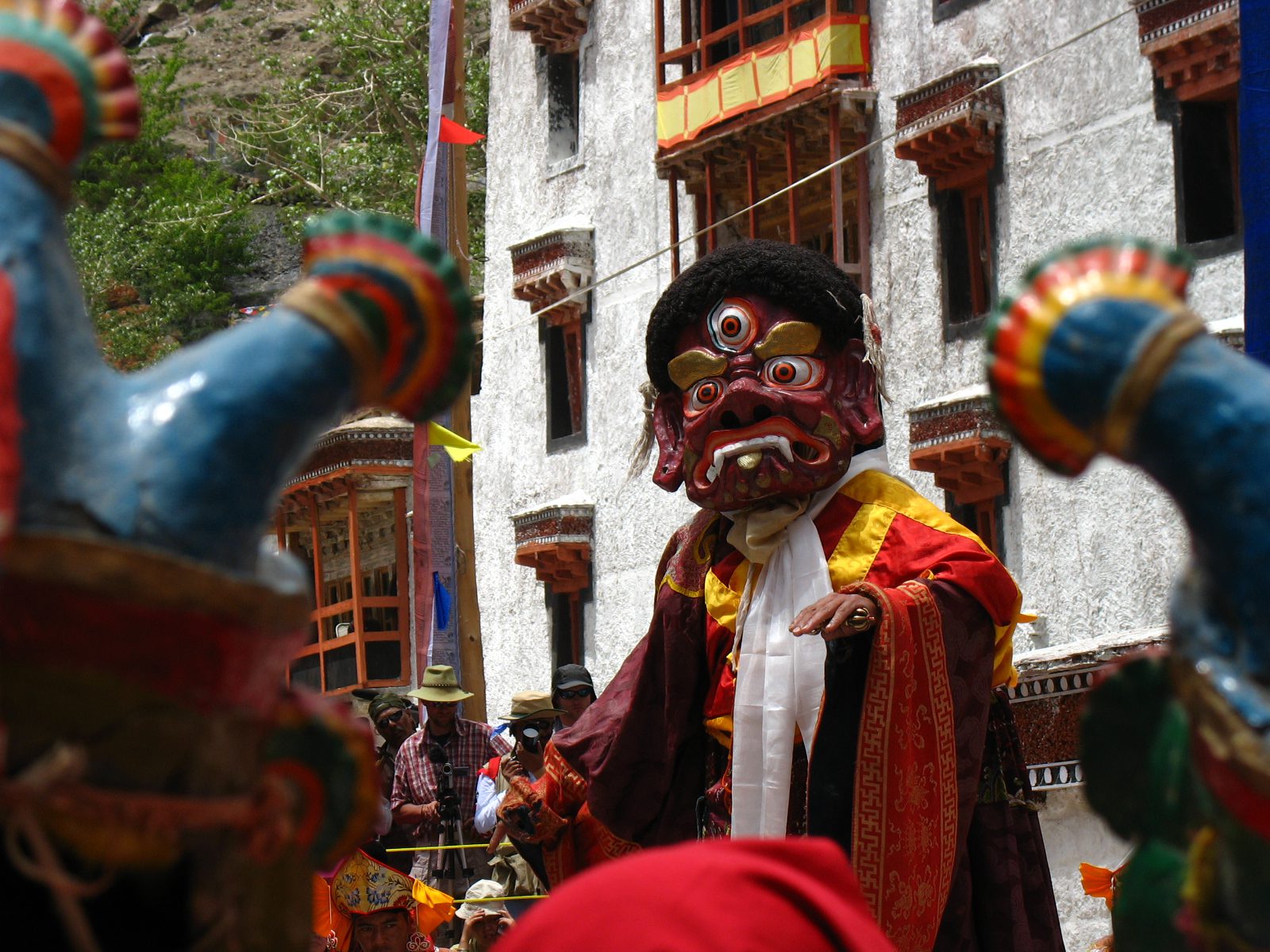
Sacred Calendars and Celestial Timings: When the Heart Beats Loudest
In Ladakh, time doesn’t flow in a straight line. It spirals. It bends with the moon and dances with the stars. To witness a festival here is to enter a moment that has been waiting for you—not because of a fixed date on a calendar, but because the cosmos said: now.
The rhythm of Ladakhi life is measured not in hours or weeks, but in lunar cycles and solar shifts. The great festivals—Losar, the Tibetan New Year; Dosmochey, the Festival of the Scapegoat; Hemis Tsechu, the spiritual epic—are not dictated by convenience or tourism but by the sacred almanac known as the lunar Tibetan calendar. A monk turns its pages, passed down through centuries, and from the sky’s silence comes an answer.
This is why there are no fixed festival dates printed years in advance. The mountains don’t work like that. Seasons shift. Snow comes early. Rivers flood and dry. And so the timing of the festival is part of the mystery, a cosmic invitation you must listen for, rather than plan around.
I once arrived in Leh just as the preparations for Dosmochey began. It was February, still deep in winter. The town was wrapped in frost and silence. And yet, the air shimmered with anticipation. Monks stitched together ceremonial effigies. Families lit butter lamps in corners of their homes. Even the dogs seemed to bark more rhythmically. No posters. No loud announcements. Just a whisper of purpose carried on the wind.
If you’re planning your journey to Ladakh, don’t just ask “when should I go?” Instead, ask, “what does the land want to show me this season?” Losar in the dead of winter teaches you warmth in community. Hemis in the height of summer shows you Ladakh in full bloom—fields of barley swaying behind ancient stone walls, monastery walls vibrating with chants, dancers spinning in sunlight.
European travelers often seek out summer for comfort, and indeed, July brings many of the grandest festivals. But those who brave the off-season celebrations—the wind-chilled rites of February or the golden harvest dances of late September—often leave with a deeper imprint, a memory that feels less like a photo and more like something etched inside the bones.
Ladakh’s festival calendar isn’t just a guide to events. It is a sacred choreography of time and spirit. When you align your steps with its rhythm, you don’t just visit a place—you participate in its pulse.
So listen. Not to the dates on a brochure, but to the drumbeat in the sky. The mountains will let you know when it’s time.

Village Gatherings and Remote Revelry: Where Tourists Rarely Tread
Most visitors to Ladakh follow the rhythm of the well-known: the grand spectacle of Hemis, the dramatic courtyards of Thiksey, the chants that echo through Lamayuru. But far from these landmark monasteries, tucked into the folds of hills and beyond the bends of dust roads, are celebrations that live quietly and vividly in Ladakh’s villages.
Here, festivals don’t come with brochures or banners. They arrive like a change in the weather—sensed first by the elders, then passed from house to house in murmured excitement. A pot of butter tea is stirred with more care. Scarves are pressed. The drum, silent for weeks, is gently tested by young hands. The entire village becomes a stage, and every heart beats in time.
I was once invited—unexpectedly, and without ceremony—to such a gathering in Chiktan, a village that doesn’t appear in glossy magazines or airport posters. It was harvest season, and the apricots had just been dried and packed into woven baskets. In the courtyard of a stone house with faded blue windows, women danced in slow circles, their silver jewelry clinking like wind chimes. A boy no older than ten played a two-sided drum with the focus of a monk. There were no spectators. Only participants. And soon, I found myself among them.
These offbeat festivals in remote Himalayan villages are more than events. They are living memory. They mark not only the seasons but the survival of culture—practices passed from mother to daughter, from lama to novice, from story to song. In places like Turtuk, Dha, or Garkone, where influences mingle and languages shift with altitude, each celebration becomes a signature of place and people.
What makes these moments unforgettable is not their scale, but their sincerity. You may sit cross-legged in a smoky kitchen, sharing barley wine with a stranger who now calls you cousin. You may hear a love song sung in a dialect you don’t understand, yet somehow feel it settle in your chest. You may witness a grandmother cry as she watches her granddaughter perform an old prayer-dance, one she herself danced long before roads reached this village.
For European travelers seeking the genuine over the grand, this is the Ladakh you will carry home. Not in photos or souvenirs, but in sensations—in the taste of wild garlic soup, in the echo of a mountain drum, in the warmth of a borrowed shawl at dusk.
To reach these places requires patience, humility, and an openness to being changed. But if you do, you will not find just a festival. You will find a home—temporary perhaps, but no less real.

Sounds, Colors, and Stories: What Festivals Reveal About Ladakhi Identity
A festival in Ladakh is never just a performance. It is a layered tapestry, woven from generations of memory, belief, and belonging. To truly witness it, you must learn to see not just with your eyes—but with your ears, your skin, and the quiet corners of your heart.
There is sound, yes—the deep pulse of ceremonial drums, the sharp cry of long horns echoing across the valley, the rising chants of monks that seem to hang in the cold air like morning mist. But within that sound is silence too: the attentive hush of children in the front row, the moment between steps when a dancer’s foot has not yet returned to the earth, the respectful stillness of an old man bowing his head before a masked deity.
Then there is color. Not the polished palette of postcards, but the lived-in hues of devotion: robes faded by sun and prayer, hand-dyed scarves that match the ochre of the mountains, masks so vividly painted they seem to breathe. Every item worn or carried during a festival—be it a turquoise-studded headdress or a belt of embroidered wool—tells a story. Often, these pieces are passed down through families, connecting today’s dances to the dreams of long-gone ancestors.
And of course, there are the stories. Every spin, every stomp, every sweeping gesture in a festival dance is a narrative. They recount ancient battles between virtue and illusion, the life journeys of compassionate saints, the cosmic cycles of birth, death, and awakening. These stories, performed in open courtyards and windswept monasteries, are Ladakh’s living literature—never written in books, but carried in bodies, rhythms, and breath.
When I attended a village festival near Alchi, I sat beside a girl who was no more than twelve. She whispered translations of the masked dancers’ movements into my ear—fragments of myth she’d learned from her grandmother. Her voice trembled with pride, not because she knew the stories, but because she knew she belonged to them. And in that moment, I realized something: the festival was not just a reflection of Ladakhi identity. It was how identity is kept alive.
For European travelers used to museums and static exhibitions, this may come as a revelation. In Ladakh, history does not sit quietly behind glass—it dances. It sings. It weaves itself into barley fields and monastery walls. The culture is not curated. It is lived.
To witness a Ladakhi festival, then, is to step into a shared dream. One where the past is not forgotten, but reawakened with each drumbeat, each chant, each slow and sacred turn. And once you’ve seen it, truly seen it, you carry it with you—across borders, through seasons, into your own stories.
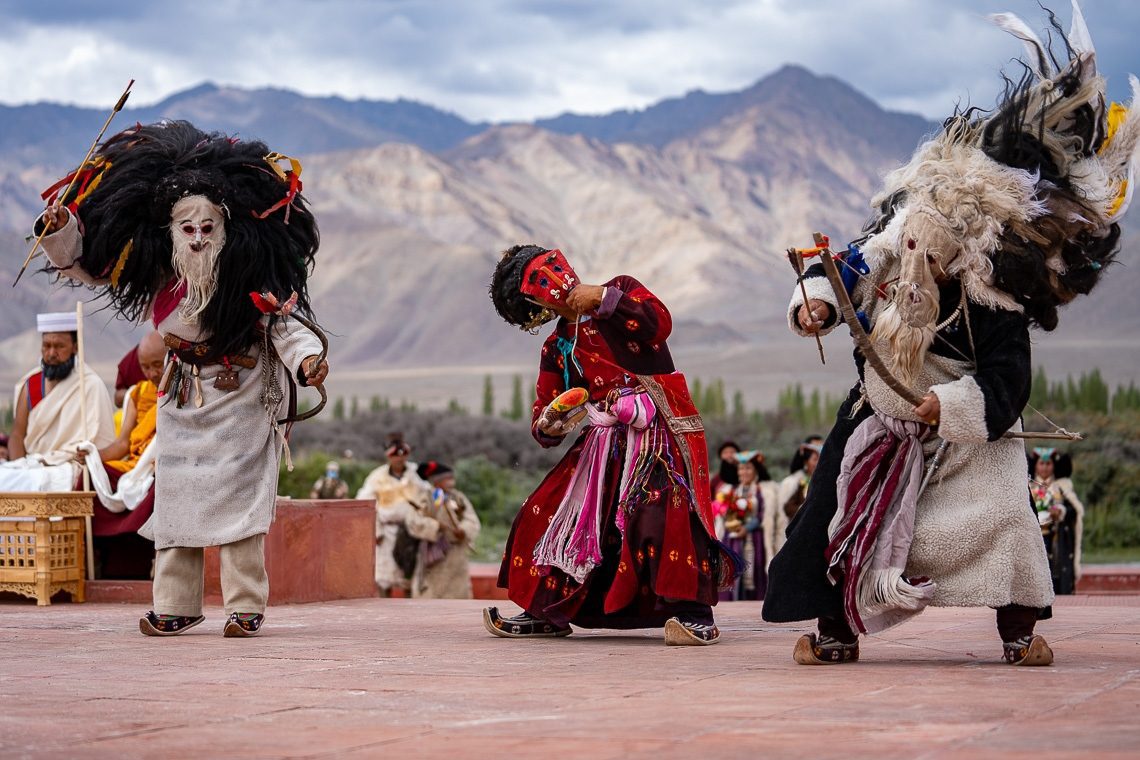
Traveling with Intention: Tips for the Festival-Seeking Traveler
To witness a Ladakhi festival is to step into a sacred circle—and how you enter that space matters. In a land where the spiritual and the everyday are intertwined, travel becomes more than movement. It becomes an act of respect, of presence, of listening.
If you’re planning your journey around Ladakh’s vibrant celebrations, know this: the most unforgettable experiences often come unannounced. You might stumble upon a harvest ritual in a barley field or be invited into a monastery’s inner sanctum for an unexpected rite. Be flexible with your itinerary. Let the land lead.
1. Ask, don’t assume. Not every dance is meant for cameras. Some rituals are private, and some chants are not meant to be echoed. Before taking photos or recording videos, seek permission—ideally from a monk or elder, not just a fellow tourist. A smile and a quiet question can go a long way.
2. Dress with awareness. Ladakhi festivals are often held at high-altitude monasteries or outdoor courtyards. Layer for warmth, but also for modesty. Shawls, long sleeves, and muted colors show reverence. Avoid flashy prints or revealing clothes, especially when entering sacred spaces.
3. Listen more than you speak. You are a guest—not only of the community, but of its ancestors. Let yourself be guided by rhythms you don’t understand. Watch the way elders sit, the way children clap in time, the way the dancers move in harmony with wind and mountain.
4. Give without expectation. Small offerings are often welcome—candles, incense, even help carrying water or setting up chairs. But don’t give for the photo. Give because you’re part of the circle, even if only for a moment. Many travelers find these shared acts become the most meaningful souvenirs.
5. Support what sustains. Buy local, eat local, sleep local. Stay in family-run homestays during festival times. Attend the village market after the dance ends. Share tea with the musicians. These simple gestures nourish the very culture you’ve come to witness.
6. Follow the seasons, not the crowds. While July and August draw the most visitors, consider the lesser-known festivals in winter or autumn—when the air is crisper, the crowds are thinner, and the celebrations are even more heartfelt. In February’s stillness or September’s golden light, you may find Ladakh most generous.
And finally, travel with intention. Don’t chase the perfect photo or the busiest festival. Chase the stillness between drumbeats, the eye contact with a masked dancer, the warmth of a cup of butter tea offered by a stranger. These are the real moments. The ones that travel home with you long after your boots are dusted and the mountains have vanished behind the clouds.
The drum will call. When it does, answer not with a rush, but with reverence.
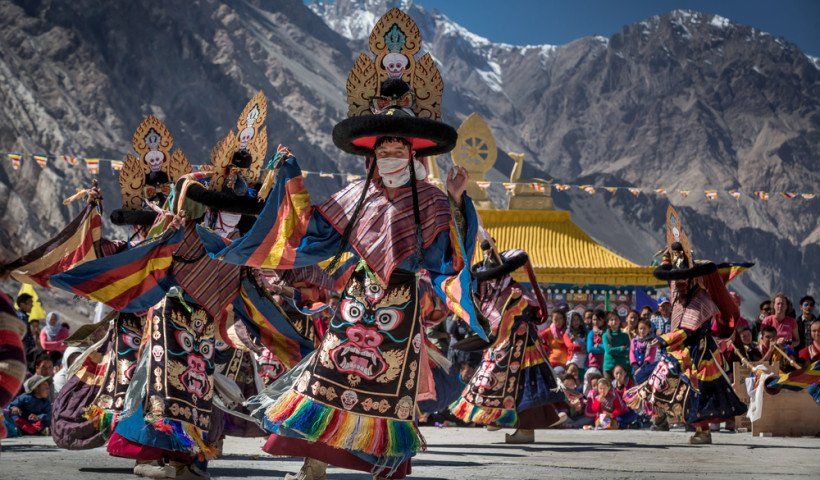
When the Drumbeat Follows You Home
You may leave Ladakh. The plane may rise above the mountains, your boots may rest beside an ordinary doorway once more, and your skin may no longer crack from high-altitude air. But some part of you—a quieter, deeper part—will still be dancing.
Long after the last festival fades into memory, the drumbeat remains. It surfaces unexpectedly—in the hush of early morning, in the rhythm of your footsteps on a familiar street, in the way sunlight hits a stone wall. The sound is no longer external. It has become yours.
Because Ladakh’s festivals are not just events to be attended. They are encounters with the sacred, with a people who remember what modernity has often forgotten: that life is ceremony, that community is the first temple, that silence has music, and that movement can be prayer.
And if you were lucky enough to stand in a monastery courtyard as masked monks whirled through ancient myths, or to share a barley cake with a stranger beside a mountain fire, then you’ve felt it—the thin, glowing thread that connects you to something older and wiser than words.
European travelers often arrive here seeking beauty, adventure, perhaps a change of pace. But they leave with something else: a resonance. The slow echo of a place that does not demand to be understood, only witnessed. A rhythm that reawakens something essential—something human.
So when you return to your own landscapes—whether the vineyards of Italy, the forests of Germany, or the cobblestone streets of Spain—listen closely. The festival continues. Not with drums or dancers, but with the way you see the world differently now. With a little more slowness. A little more reverence. A little more joy.
Because once you’ve danced with the drums in Ladakh, you don’t just remember the rhythm. You become it.

About the Author|Elena Marlowe
Elena Marlowe is an Irish-born essayist now living in a quiet village near Lake Bled, Slovenia.
With a background in cultural anthropology and storytelling, she gathers tales the way some collect wildflowers—gently, intuitively, and with deep respect for the places they grow.
Her writings explore the quiet intersections of landscape, memory, and belonging, drawing readers into moments where travel becomes transformation and stories become shelter.
When she’s not writing, she can often be found walking forest paths, listening to church bells echo across alpine lakes, or sharing tea with strangers who become friends.

